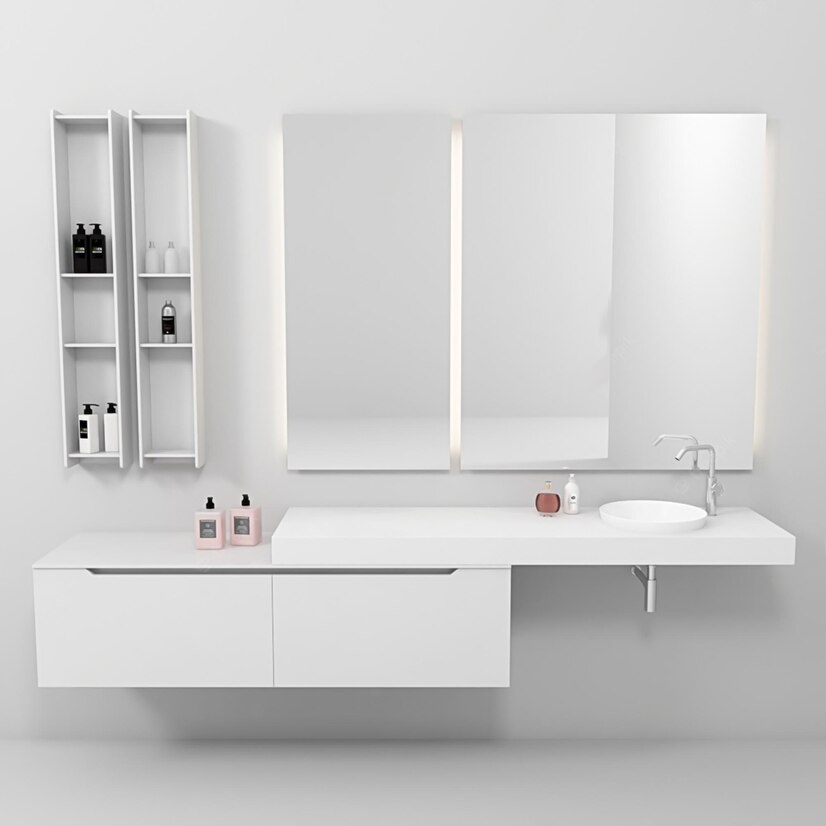Bathroom renovations can be expensive, and costs can quickly spiral out of control. However, there is a budget-friendly option that doesn’t compromise on style or functionality – wall hung vanities. In this article, we’ll explore why wall hung vanity is a cost-effective choice for a bathroom renovation and provide tips for saving even more money.
What are Wall Hung Vanities?
Wall hung vanities are a type of bathroom vanity that is mounted on the wall, rather than sitting on the floor. They typically feature a sleek, modern design and are available in a variety of materials, sizes, and styles. Some popular materials include wood, glass, and stone, while styles range from minimalist and contemporary to more traditional and ornate.
One of the primary advantages of vanities wall hung is their space-saving design. Since they are mounted on the wall, they don’t take up as much floor space as traditional vanities, making them an excellent choice for smaller bathrooms. Additionally, wall hung vanities can be customized to fit any bathroom size or layout, and can even be designed with storage options like shelves or drawers.
Cost Comparison: Wall Hung Vanities vs Traditional Vanities
When it comes to cost, wall hung vanities are often a more affordable option than traditional vanities. Traditional vanities can be costly due to their larger size, the materials used, and the additional costs associated with plumbing and installation. On the other hand, wall hung vanities are smaller and easier to install, which can help keep costs down.
For example, a standard 36-inch traditional bathroom vanity can cost anywhere from $500 to $2,500 or more, depending on the materials and features. In contrast, a wall hung vanity of similar size and quality can cost between $200 to $1,000, including the sink and faucet. This significant price difference is due to the simpler installation process, the lack of a cabinet base, and the use of less material.
Factors that Affect the Cost of Wall Hung Vanities
While wall hung vanities are generally more affordable than traditional vanities, the cost can vary depending on several factors. One of the most significant factors is the materials used for the vanity. High-end materials like marble or granite can increase the cost, while more affordable options like laminate or MDF can help keep costs down.
Another factor is the size and design of the vanity. A larger or more elaborate vanity will naturally be more expensive than a smaller or simpler one. Additional features like double sinks, built-in storage, or high-end faucets can also increase the cost.
Tips for Saving Money on Wall Hung Vanities
If you’re looking to save even more money on a wall hung vanity, there are several tips and tricks to keep in mind. For example, you can save money by installing the vanity yourself instead of hiring a professional. Most wall hung vanities come with easy-to-follow instructions, and all you need is a few basic tools.
Another way to save money is by shopping around for the best deals on wall hung vanities. Many online retailers offer competitive prices, and you can often find discounts or sales if you’re willing to wait. Additionally, consider looking for deals on discontinued or overstocked items, or consider purchasing a floor model for a significant discount.
Finally, you can save money on a wall hung vanity by repurposing an old vanity or other bathroom fixture. For example, you could ref
inish an old dresser or cabinet and add a sink and faucet to create a unique vanity wall hung. This DIY approach can save you money while also adding a personal touch to your bathroom renovation.

FAQs:
What is the difference between a wall hung vanity and a floating vanity?
A wall hung vanity is mounted directly onto the wall, while a floating vanity is attached to the wall using a bracket or other support system that is hidden from view. Both styles have a modern, space-saving design, but a floating vanity can provide a more substantial visual impact.
Can a wall hung vanity be installed on any type of wall?
Yes, a wall hung vanity can be installed on any type of wall, including drywall, concrete, or plaster. However, it’s essential to ensure that the wall can support the weight of the vanity and any additional items, like the sink and faucet.
Do wall hung vanities require special plumbing?
No, wall hung vanities do not require special plumbing. They typically use the same type of plumbing as traditional vanities and can be installed by a professional plumber or by a knowledgeable DIYer.
How do I choose the right size wall hung vanity for my bathroom?
The size of your wall hung vanity will depend on the size of your bathroom and the available wall space. Measure the wall space where you plan to install the vanity and choose a size that fits comfortably within that space. Additionally, consider the height of the vanity and whether it will be comfortable to use.
What type of sink and faucet should I choose for a wall hung vanity?
The type of sink and faucet you choose will depend on your personal style and budget. Some popular options include vessel sinks, undermount sinks, and pedestal sinks, while faucet styles range from modern and minimalist to more traditional and ornate. Choose a sink and faucet that complement the style of your vanity and your overall bathroom design.
Conclusion:
A bathroom renovation can be a costly undertaking, but it doesn’t have to break the bank. By choosing a cost-effective option like a wall hung vanity, you can save money without sacrificing style or functionality. Whether you’re looking for a sleek and modern design or a more traditional look, wall hung vanities offer a range of options to fit any bathroom style and budget. With these tips and tricks, you can save even more money on your bathroom renovation and enjoy a beautiful, functional space for years to come.